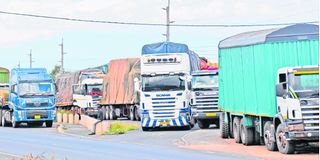
Our Projects are
Transforming African Trade
Quick Contacts
2nd Floor, Fidelity Insurance Centre Waiyaki Way, Westlands

What you need to know:
Arusha. The East African Community (EAC) is seeking to boost intra-regional trade to at least 40 percent of its trade with the rest of the world in five years – up from 11 percent currently.
Fostering regional trade, resource mobilisation and integrating new partner states are at the core of the EAC’s New Year agenda.
Attaining the target means increased efforts to eliminate a host of trade barriers that have persisted for years.
EAC secretary-general Peter Mathuki has outlined measures, which he believes will foster intra-regional trade to the desired level.
These include optimising the implementation of the Customs Union and Common Market protocols and implementing the four-band Common External Tariff (CET) to enhance trade competitiveness.
Two years ago, the regional economic bloc adopted a CET structure of zero percent, 10 percent, 25 percent and 30-35 percent.”We endeavour to continue with its implementation to facilitate trade competitiveness,” Dr Mathuki said in his New Year address to EAC staff.
He added that non-tariff barriers (NTBs) were to blame for low intra-regional trade that was in 2022 estimated to be only 11 percent of EAC’s trade with the rest of the world.
“We need to work together to eliminate NTBs hindering intra-regional trade,” Dr Mathuki said, adding that he was optimistic intra-regional trade in East Africa would rise to at least 40 percent in the next five years.
Fostering regional trade would entail resource mobilisation from multiple sources and the EAC would work with all partner states to expedite the operationalisation of the financing formula to maximise the bloc’s performance, he said.
“We are mulling a sectoral council meeting with Finance ministers to discuss implementation of this directive, as well as a strategy to rationalise the cost of doing business within the bloc.”
The EAC is expected to prioritise revitalising relations with development partners, the private sector and civil society this year.
Development partners contribute about a half of the EAC’s annual budgets of around $100 million.
Intra-regional trade has, nevertheless, been on an upward trajectory with goods and services transacted during 2022 valued at $10.1 billion.
In 2021, trade within the bloc – which they comprised six nations then before the admission of DR Congo – was valued at $9.8 billion.
The EAC’s exports to the rest of the world were valued at $20.139 billion in 2022.
Total imports from the rest of the world into the region amounted to $53.891 billion, according to the East African Legislative Assembly (Eala).
Read original article
Disclaimer: The views and opinions expressed in this article are those of the authors and do not necessarily reflect the official policy or position of TradeMark Africa.